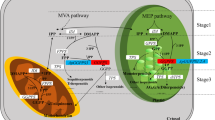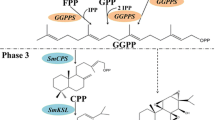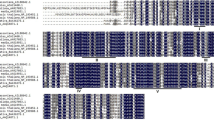Abstract
The root of Euphorbia pekinensis as a traditional herbal medicine has been recorded in Chinese pharmacopoeias for the treatment of oedema, gonorrhea, migraine and wart cures. In this work, we reported on the cDNA cloning and characterization of a novel farnesyl diphosphate synthase (FPS) from E. pekinensis. The full-length cDNA named EpFPS (Genbank Accession Number FJ755465) contained 1431 bp with an open reading frame of 1029 bp encoding a polypeptie of 342 amino acids. The deduced amino acid sequence of the EpFPS named EpFPS exhibited a high homology with other plant FPSs, and contained five conserved domains. Phylogenetic analysis showed that EpFPS belonged to the plant FPS group. Southern blot analysis revealed that there exists a small FPS gene family in E. pekinensis. Expression pattern analysis revealed that EpFPS expressed strongly in root, weak in leaf and stem. In callus, expression of EpFPS gene and biosynthesis of triterpenoids were strongly induced by Methyl jasmonate and slightly induced by Salicylic acid. Functional complementation of EpFPS in an ergosterol auxotrophic yeast strain indicated that the cloned cDNA encoded a functional farnesyl diphosphate synthase.




Similar content being viewed by others
References
Rohdich F, Bacher A, Eisenreich W (2005) Isoprenoid biosynthetic pathways as anti-infective drug targets. Biochem Soc Trans 33:785–791
Slichenmeyer WJ, Von Hoff DD (1991) Taxol: a new and effective anti-cancer drug. Anti-Cancer Drugs 2:519–530
Creasey WA (1981) The vinca alkaloids and similar compounds. Cancer Chemother 3:79–96
Cragg GM, Newman DJ (2003) Plants as a source of anti-cancer and anti-HIV agents. Ann Appl Biol 143:127–133
Newman JD, Chappell J (1997) Isoprenoid biosynthesis in plants: carbon partitioning within the cytoplasmic pathway. Crit Rev Biochem Mol Biol 34:95–106
Rodriguez-Concepcion M, Boronat A (2002) Elucidation of the methylerythritol phosphate pathway for isoprenoid biosynthesis in bacteria and plastids. A metabolic milestone achieved through genomics. Plant Physiol 130:1079–1089
Kawamukai M (2002) Biosynthesis, bioproduction and novel roles of ubiquinone. J Biosci Bioeng 94:511–517
Hecker E (1977) New toxic, irritant and cocarcinogenic diterpenoids esters from Euphorbiaceae and from Thymelaeaceae. Pure Appl Chem 49:1423–1431
Mucsi I, Molnar J, Hohmann J, Redei D (2001) Cytotoxicities and anti-herpes simplex virus activities of diterpenes isolated from Euphorbia species. Planta Med 67:672–674
Wu TS, Lin YM, Haruna M, Pan DJ, Shingu T, Chen YP, Hsu HY, Nakano T, Lee KH (1991) Antitumor agents, 119 Kansuiphorins A and B, two novel antileukemic diterpene esters from Euphorbia kansui. J Nat Prod 54:823–829
Kupchan SM, Uchida I, Branfman AR, Dailey RG Jr, Fei BY (1976) Antileukemic principles isolated from euphorbiaceae plants. Science 191:571–572
Lanhers MC, Fleurentin J, Dorfman P, Mortier F, Pelt JM (1991) Analgesic, antipyretic and anti-inflammatory properties of Euphorbia hirta. Planta Med 57:225–231
Liang Q, Dai C, Jiang J, Tang Y, Duan J (2009) A new cytotoxic casbane diterpene from Euphorbia pekinensis. Fitoterapia 80:514–516
Kong L, Li Y, Wu X, Min Z (2002) Cytotoxic diterpenoids from Euphorbia pekinensis. Planta Med 68:813–817
Matsushita Y, Kang WK, Charlwood BV (1996) Cloning and analysis of a cDNA encoding farnesyl diphosphate synthase from Artemisia annua. Gene 172:207–209
Adiwilaga K, Kush A (1996) Cloning and characterization of cDNA encoding farnesyl diphosphate synthase from rubber tree (Hevea brasiliensis). Plant Mol Biol 30:935–946
Sanmiya K, Iwasaki T, Matsuoka M, Miyao M, Yamamoto N (1997) Cloning of a cDNA that encodes farnesyl diphosphate synthase and the blue-light-induced expression of the corresponding gene in the leaves of rice plants. Biochim Biophys Acta 1350:240–246
Delourme D, Lacroute F, Karst F (1994) Cloning of an Arabidopsis thaliana cDNA coding for farnesyl diphosphate synthase by functional complementation in yeast. Plant Mol Biol 26:1867–1873
Attucci S, Aitken SM, Ibrahim RK, Gulick PJ (1995) A cDNA encoding farnesyl pyrophosphate synthase in white lupine. Plant Physiol 108:835–836
Murashige T, Skoog F (1962) A revised medium for rapid growth and bioassays with tobacco tissue cultures. Physiol Plant 15:473–497
Taylor B, Powell A (1982) Isolation of plant DNA and RNA. Focus 4:4–6
Holtke HJ, Ankenbauer W, Muhlegger K, Rein R, Sagner G, Seibl R, Walter T (1995) The digoxigenin (DIG) system for non-radioactive labeling and detection of nucleic acids: an overview. Cell Mol Biol 41:883–905
Vongsangnak W, Gua J, Chauvatcharin S, Zhong JJ (2004) Towards efficient extraction of notoginseng saponins from cultured cells of Panax notoginseng. Biochem Eng J 18:115–120
Chen AJ, Kroon PA, Poulter CD (1994) Isoprenyl diphosphate synthases: Protein sequence comparisons, a phylogenetic tree, and predictions of secondary structure. Protein Sci 3:600–607
Kim OT, Ahn JC, Hwang SJ, Hwang B (2005) Cloning and expression of a farnesyl-diphosphate synthase in Centella asiatica (L.). Urban Mol Cells 19:294–299
Cunillera N, Arro M, Delourme D, Karst F, Boronat A, Ferrer A (1996) Arabidopsis thaliana contains two differntially expressed farnesyl-diphosphate synthase genes. J Biol Chem 271:7774–7780
Li CP, Larkins BA (1996) Identification of a maize endosperm-specific cDNA encoding farnesyl pyrophosphate synthetase. Gene 171:193–196
Hemmerlin A, Rivera SB, Erickson HK, Poulter CD (2003) Enzymes encoded by the farnesyl-diphosphate synthase gene family in the big sagebrush Artemisia tridentate ssp spiciformis. J Biol Chem 278:32132–32140
Wang P, Liao Z, Guo L, Li W, Chen M, Pi Y, Gong Y, Sun X, Tang K (2004) Cloning and functional analysis of a cDNA encoding Ginkgo biloba farnesyl diphosphate synthase. Mol Cells 18:150–156
Cao X, Zong Z, Ju X, Sun Y, Da C, Liu Q, Jiang J (2010) Molecular cloning, characterization and function analysis of the gene encoding HMG-CoA reductase from Euphorbia Pekinensis Rupr. Mol Biol Rep 37:1559–1567
Wasternack C, Parthier B (1997) Jasmonate signaled plant gene expression. Trends Plant Sci 2:302–307
Huang B, Yi B, Duan Y, Sun L, Yu X, Guo J, Chen W (2008) Characterization and expression profiling of tyrosine aminotransferase gene from Salvia miltiorrhiza (Dan-shen) in rosmarinic acid biosynthesis pathway. Mol Biol Rep 35:79130–79132
Durner J, Shah J, Kessig DF (1997) Salicylic acid and disease resistance in plants. Trends Plant Sci 2:266–274
Wang Y, Miao Z, Tang K (2010) Molecular cloning and functional expression analysis of a new gene encoding geranylgeranyl-diphosphate synthase from hazel (Corylus avellana L. Gasaway). Mol Biol Rep 37:3439–3444
Liao P, Zhou W, Zhang L, Wang J, Yan X, Zhang Y, Zhang R, Li L, Zhou G, Kai G (2009) Molecular cloning, characterization and expression analysis of a new gene encoding 3-hydroxy-3-methylglutaryl coenzyme A reductase from Salvia miltiorrhiza. Acta Physiol Plant 31:565–572
Blanchard L, Karst F (1993) Characterization of a lysine-to-glutamic acid mutation in a conservative sequence of farnesyl diphosphate synthase from Saccharomyces cerevisiae. Gene 125:185–189
Chambon C, Ladeveze V, Oulmouden A, Servouze M, Karst F (1990) Isolation and properties of yeast mutants affected in farnesyl diphosphate synthetase. Curr Genet 18:41–46
Acknowledgments
This research was financially supported by the National Natural Science Funds of China (30872028) and a project funded by the Priority Academic Program Development of Jiangsu Higher Education Institutions.
Author information
Authors and Affiliations
Corresponding author
Electronic supplementary material
Below is the link to the electronic supplementary material.
Rights and permissions
About this article
Cite this article
Cao, X., Yin, T., Miao, Q. et al. Molecular characterization and expression analysis of a gene encoding for farnesyl diphosphate synthase from Euphorbia pekinensis Rupr. Mol Biol Rep 39, 1487–1492 (2012). https://doi.org/10.1007/s11033-011-0886-z
Received:
Accepted:
Published:
Issue Date:
DOI: https://doi.org/10.1007/s11033-011-0886-z




